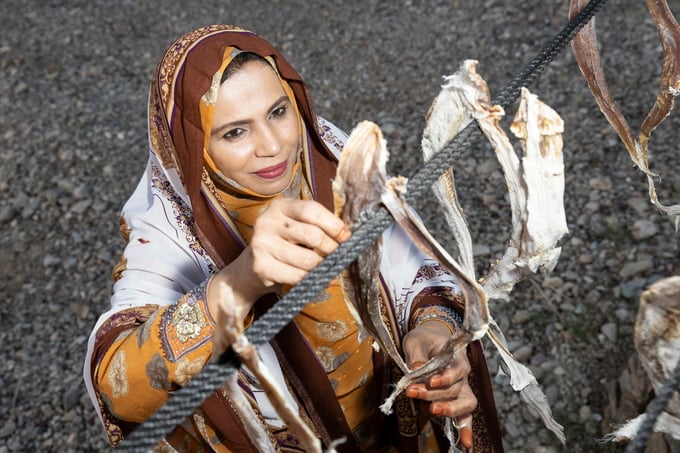June 17, 2025 | 23:55 GMT +7
June 17, 2025 | 23:55 GMT +7
Hotline: 0913.378.918
June 17, 2025 | 23:55 GMT +7
Hotline: 0913.378.918

Hanging shark to dry in Oman.
Around 1.23 billion people were employed in the world’s agrifood systems in 2019, and more than three times that figure, or almost half the world’s population, live in households linked to agrifood systems, according to new research by the Food and Agriculture Organization of the United Nations (FAO).
Of these 1.23 billion people, 857 million worked in primary agricultural production, while 375 million worked in the off-farm segments of agrifood systems.
The new figures, the first systematic and documented global estimate of its kind, derive from a range of sources and incorporate the widespread use of part-time or seasonal employment in the sector. The figures also refer to agrifood systems rather than agricultural sectors, reflecting the increasing importance of off-farm activities in feeding the world’s population, currently 8 billion and growing.
“Policy and practical agendas on the national and global level must and are addressing the challenges facing agrifood systems in an integrated way, and to keep up, data must move beyond silo-based notions such as farm employment and include the whole process from food production through processing and transport to the consumer -everything that goes into what we eat,” said Ben Davis, Director of FAO’s Inclusive Rural Transformation and Gender Equality Division and lead author of the report.
“Making sure that agrifood systems are sustainable requires factoring in nutrition, health and climate change,” he added.
The study entitled “Estimating Global and Country Level Employment in Agrifood Systems” was published as a Working Paper by FAO’s Statistics Division. In addition to a team from FAO, other authors include Kate Schneider, from the Paul H. Nitze School of Advanced International Studies, Johns Hopkins University, Ramya Ambikapathi, from the Department of Global Development at Cornell University, and Paul Winters, from the Keough School of Global Affairs, University of Notre Dame.
The new exercise adopts a harmonized approach using econometric modeling based on data from the International Labour Organization and validated with household surveys from FAO’s Rural Livelihoods Information System (RuLIS) database, as explained in the Working Paper.
Key Findings
The largest number of people employed in agrifood systems, 793 million, is in Asia, followed by almost 290 million in Africa.
The majority of the economically active population in low-income countries, particularly in Africa, had at least one job or activity in agrifood systems.
Including relevant trade and transportation activities, 62 percent of employment in Africa is in agrifood systems, compared to 40 percent in Asia and 23 percent in the Americas.
The share of agrifood system employment out of total employment that is not directly in the agricultural sectors ranges from 8 percent in Europe to 14 percent in Africa.
In most of the countries for which data from RuLIS is available, youth, defined as people aged 15 to 35 years old, make up around half of all agrifood system workers, and their share is usually higher in food processing and services.
Of the 3.83 billion people reliant on agrifood systems for their livelihoods, 2.36 billion live in Asia and 940 million in Africa.
The first year of the COVID-19 pandemic led to a 6.8 percent reduction in the number of employed in agrifood systems. The impact of COVID-19 was highest in Latin America, where employment dropped 18.8 percent.
On 13 April, FAO will publish a pioneering report on The Status of Women in Agrifood Systems, in which the data on employment in agrifood systems from the Working Paper is further disaggregated by sex.
Background
A comprehensive measure of employment in agrifood systems offers precious information for decision makers, and FAO hopes to muster support for turning the latest research into an ongoing statistical data series.
Agrifood systems encompass primary agricultural production of food and non-food products, the production of food of non-agricultural origin, the food supply chain from producer to consumer and the final consumer of food. Globally, these systems produce some 11 billion tonnes of food each year and form the backbone of many economies.
Robust data of this sort is essential to help assure that agrifood system transformation delivers new jobs, particularly in low-income countries with large young populations, and does so in an equitable manner.
As countries develop, the share of employment in agrifood systems decreases. This is driven primarily by a reduction in employment in agriculture. As countries move from lower to higher income, the share of the agrifood systems workforce directly engaged in agriculture typically declines, while that engaged in off farm employment in food processing, services, trade and transport grows.
FAO also found that counting people engaged in secondary labour activities or household farming activities - such as a full-time school teacher who grows produce for sale on their land - in agrifood systems adds around 24 percent on average to the number of those whose livelihoods depend on those systems.
(FAO.org)

(VAN) Extensive licensing requirements raise concerns about intellectual property theft.

(VAN) As of Friday, a salmonella outbreak linked to a California egg producer had sickened at least 79 people. Of the infected people, 21 hospitalizations were reported, U.S. health officials said.

(VAN) With the war ongoing, many Ukrainian farmers and rural farming families face limited access to their land due to mines and lack the financial resources to purchase needed agricultural inputs.

(VAN) Vikas Rambal has quietly built a $5 billion business empire in manufacturing, property and solar, and catapulted onto the Rich List.

(VAN) Available cropland now at less than five percent, according to latest geospatial assessment from FAO and UNOSAT.

(VAN) Alt Carbon has raised $12 million in a seed round as it plans to scale its carbon dioxide removal work in the South Asian nation.

(VAN) Attempts to bring down the price of the Japanese staple have had little effect amid a cost-of-living crisis.